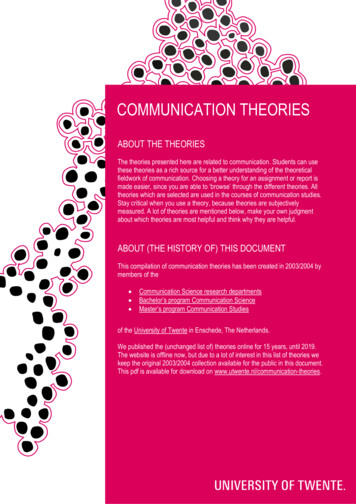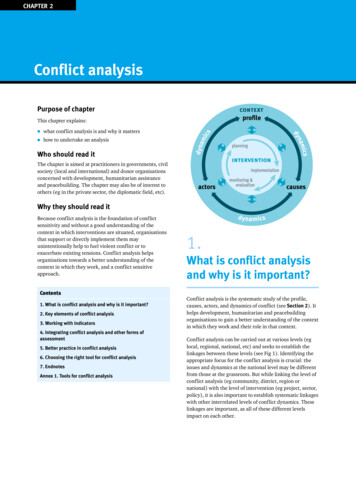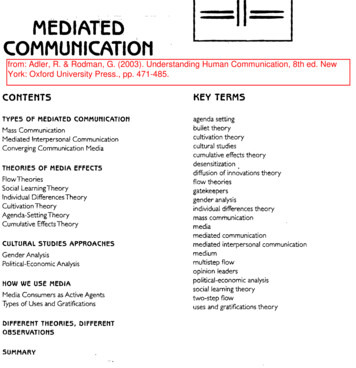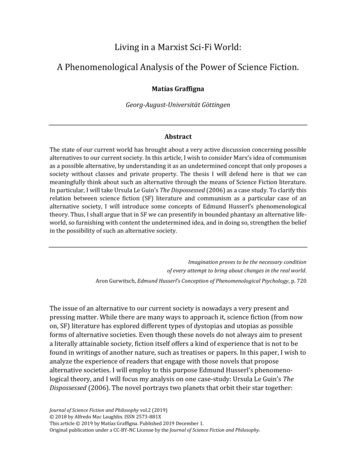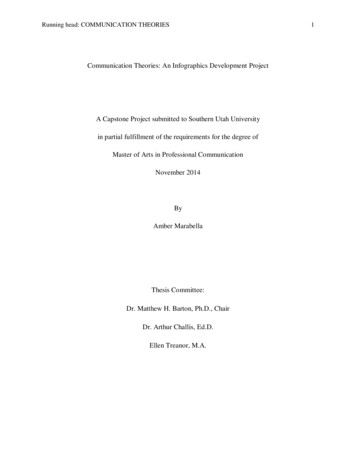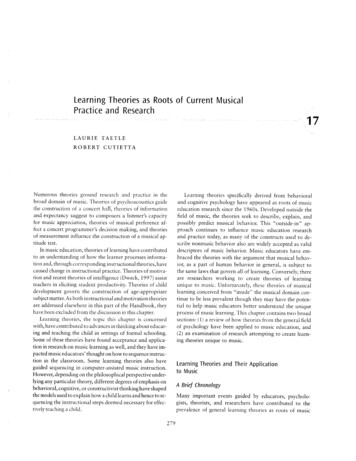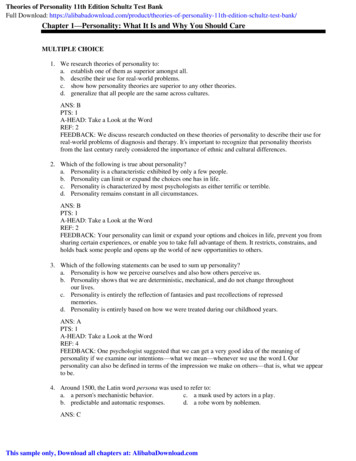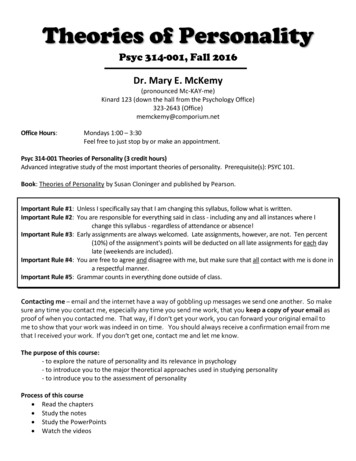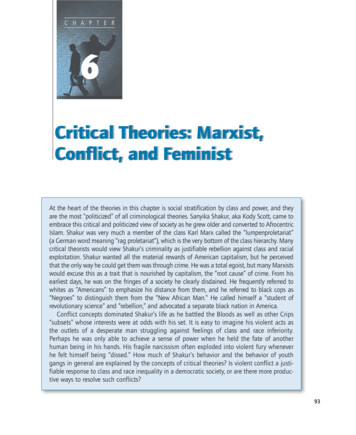
Transcription
C H A P T E R6Critical Theories: Marxist,Conflict, and FeministAt the heart of the theories in this chapter is social stratification by class and power, and theyare the most “politicized” of all criminological theories. Sanyika Shakur, aka Kody Scott, came toembrace this critical and politicized view of society as he grew older and converted to AfrocentricIslam. Shakur was very much a member of the class Karl Marx called the “lumpenproletariat”(a German word meaning “rag proletariat”), which is the very bottom of the class hierarchy. Manycritical theorists would view Shakur’s criminality as justifiable rebellion against class and racialexploitation. Shakur wanted all the material rewards of American capitalism, but he perceivedthat the only way he could get them was through crime. He was a total egoist, but many Marxistswould excuse this as a trait that is nourished by capitalism, the “root cause” of crime. From hisearliest days, he was on the fringes of a society he clearly disdained. He frequently referred towhites as “Americans” to emphasize his distance from them, and he referred to black cops as“Negroes” to distinguish them from the “New African Man.” He called himself a “student ofrevolutionary science” and “rebellion,” and advocated a separate black nation in America.Conflict concepts dominated Shakur’s life as he battled the Bloods as well as other Crips“subsets” whose interests were at odds with his set. It is easy to imagine his violent acts asthe outlets of a desperate man struggling against feelings of class and race inferiority.Perhaps he was only able to achieve a sense of power when he held the fate of anotherhuman being in his hands. His fragile narcissism often exploded into violent fury wheneverhe felt himself being “dissed.” How much of Shakur’s behavior and the behavior of youthgangs in general are explained by the concepts of critical theories? Is violent conflict a justifiable response to class and race inequality in a democratic society, or are there more productive ways to resolve such conflicts?93
94CRIMINOLOGY: THE ESSENTIALSy TheConflict Perspective of SocietyAlthough all sociological theories of crime contain elements of social conflict, consensus theories tend to judgealternative normative systems from the point of view of mainstream values, and they do not call for majorrestructuring of society. Theories presented in this chapter do just that, and concentrate on power relationshipsas explanatory variables to the exclusion of almost everything else. They view criminal behavior, the law, andthe penalties imposed for breaking it, as originating in the deep inequalities of power and resources existing insociety. For conflict theorists, the law is not a neutral system of dispute settlement designed to protect everyone,but rather the tool of the privileged who criminalize acts that are contrary to their interests.You don’t have to be a radical or even a liberal to acknowledge that great inequalities of wealth and powerexist in every society and that the wealthy classes have the upper hand in all things. History is full of examples:Plutarch wrote of the conflicts generated by disparity in wealth in Athens in 594 B.C. (Durant & Durant, 1968,p. 55), and U.S. President John Adams (1778/1971) wrote that American society in the late 18th century wasdivided into “a small group of rich men and a great mass of poor engaged in a constant class struggle” (p. 221).y KarlMarx and RevolutionKarl Marx is the father of critical criminology. The core of Marxism is the concept of class struggle:“Freeman and slave, patrician and plebian, lord and serf, guildmaster and journeyman, in a word, oppressorand oppressed, stood in constant opposition to one another” (Marx& Engels, 1948, p. 9). The oppressors in Marx’s time were the ownersof the means of production (the bourgeoisie), and the oppressedwere the workers (the proletariat). The bourgeoisie strives to keepthe cost of labor at a minimum, and the proletariat strives to sell itslabor at the highest possible price. These opposing goals are themajor source of conflict in a capitalist society. The bourgeoisieenjoys the upper hand because capitalist societies have large armiesof unemployed workers eager to secure work at any price, thusdriving down the cost of labor. According to Marx, these economicand social arrangements—the material conditions of people’slives—determine what they will know, believe, and value, and howthey will behave.Marx and his collaborator Friedrich Engels (1948) were disdainful of criminals, describing them in terms that would make aNew York cop proud: “The dangerous class, the social scum, thatrotting mass thrown off by the lowest layers of the old society”(p. 22). These folks came from a third class in society—thelumpenproletariat—who would play no decisive role in theexpected revolution. For Marx and Engels (1965) crime was simplythe product of unjust and alienating social conditions—“the strug Photo 6.1 For Karl Marx (1818–1883), thegle of the isolated individual against the prevailing conditions”resolution of social problems such as crimewould be achieved through the creation of a(p. 367). This became known as the primitive rebellion hypothesis,socialist society characterized by communalone of the best modern statements of which is Bohm’s (2001):ownership of the means of production and an“Crime in capitalist societies is often a rational response to theequal distribution of the fruits of these labors.circumstances in which people find themselves” (p. 115).
Chapter 6. Critical Theories: Marxist, Conflict, and FeministAnother concept that is central to critical criminology is alienation (Smith & Bohm, 2008). Alienationis a condition that describes the distancing of individuals from something. For Marx, most individuals incapitalist societies were alienated from work (which they believed should be creative and enjoyable), whichled to alienation from themselves and from others. Work is central to Marx’s thought because he believedthat while nonhuman animals instinctively act on the environment as given to satisfy their immediateneeds, humans distinguish themselves from them by consciously creating their environment instead ofjust submitting to it. Alienation is the result of this discord between one’s species being and one’s behavior(e.g., mindlessly noncreative work as opposed to creative work). Marx thought that wage-labor dehumanizes human beings by taking from them their creative advantage over other animals—robbing them of theirspecies being (in effect, their human nature) and reducing them to the level of animals.When individuals become alienated from themselves, they become alienated from others and fromtheir society in general. Alienated individuals may then treat others as mere objects to be exploited andvictimized as they themselves are supposedly exploited and victimized by the capitalist system. Since thegreat majority of workers do not experience their work as creative activity, they are all dehumanized ritualists or conformists (to borrow from Merton’s modes of adaptation). If we accept this notion, then perhapsone can view criminals as heroic rebels struggling to rehumanize themselves, as some Marxist criminologists have done.Willem Bonger: The First Marxist CriminologistDutch criminologist Willem Bonger’s Criminality and Economic Conditions (1905/1969) is the first workdevoted to a Marxist analysis of crime. For Bonger, the roots of crime lay in the exploitative and alienatingconditions of capitalism, although some individuals are at greater risk for crime than others because peoplevary in their “innate social sentiments”—altruism (an active concern for the well-being of others) and itsopposite, egoism—(a concern only for one’s own selfish interests). Bonger believed that capitalism generatesegoism and blunts altruism because it relies on competition for valuable resources, setting person againstperson and group against group, leaving the losers to their miserable fates. Thus, all individuals in capitalistsocieties are infected by egoism, and all are therefore prone to crime—the poor out of economic necessity,the rich and the middle classes from pure greed. Poverty was a major cause of crime for Bonger, but itworked by way of its effects on family structure (broken homes) and poor parental supervision of theirchildren. Because of his emphasis on family structure and what he saw as the moral deficits of the poor,Bonger has been criticized by other Marxists, but he firmly believed that only by transforming society fromcapitalism to socialism would it be possible to regain the altruistic sentiment and reduce crime.Modern Marxist CriminologyContrary to Marx, modern Marxist criminologists tend to excuse criminals. William Chambliss (1976)views some criminal behavior as “no more than the ‘rightful’ behavior of persons exploited by the extanteconomic relationships” (p. 6), and Ian Taylor (1999) sees the convict as “an additional victim of the routineoperations of a capitalist system—a victim, that is of ‘processes of reproduction’ of social and racialinequality” (p. 151). David Greenberg (1981) even elevated Marx’s despised lumpenproletariat to the statusof revolutionary leaders: “[C]riminals, rather than the working class, might be the vanguard of the revolution” (p. 28). Marxist criminologists also appear to view the class struggle as the only source of all crime andto view “real” crime as violations of human rights, such as racism, sexism, imperialism, and capitalism, andaccuse other criminologists of being parties to class oppression. Tony Platt even wrote that “it is not too farfetched to characterize many criminologists as domestic war criminals” (quoted in Siegel, 1986, p. 276).95
96CRIMINOLOGY: THE ESSENTIALSIn the 1980s, Marxists calling themselves left realists began to acknowledge that predatory streetcrime is a real source of concern among the working class, who are the primary victims of it. Left realists understood that they have to translate their concern for the poor into practical, realistic socialpolicies. This theoretical shift signals a move away from the former singular emphasis on the politicaleconomy to embrace the interrelatedness of the offender, the victim, the community, and the state in thecauses of crime. It also signals a return to a more orthodox Marxist view of criminals as people whoseactivities are against the interests of the working class as well as those of the ruling class. Althoughunashamedly socialist in orientation, left realists have been criticized by more traditional Marxists whosee their advocacy of solutions to the crime problem within the context of capitalism as a sellout(Bohm, 2001).yConflict Theory: Max Weber, Power and ConflictIn common with Marx, Max Weber (1864–1920) saw societal relationships as best characterized by conflict.They differed on three key points, however: First, while Marx saw cultural ideas as molded by the economicsystem, Weber saw a culture’s economic system being molded by its ideas. Second, whereas Marx emphasized economic conflict between only two social classes, Weber saw conflict arising from multiple sources,with economic conflict often being subordinate to other conflicts. Third, Marx envisioned the end of conflictwith the destruction of capitalism, while Weber contended that it will always exist, regardless of the social,economic, or political nature of society, and that it was functional because of its role in bringing disputesinto the open for public debate.Even though individuals and groups enjoying great wealth, prestige, and power have the resourcesnecessary to impose their values on others with fewer resources, Weber viewed the various class divisionsin society as normal, inevitable, and acceptable, as do many contemporary conflict theorists (Curran &Renzetti, 2001). As opposed to Marx’s concentration on two great classes (the bourgeoisie and the proletariat) based only on economic interests, Weber focused on three types of social group that form and dissolve as their interests change—class, party, and status. A class group shares only common economicinterests, and party refers to political groups. Status groups were the only truly social groups because members hold common values, live common lifestyles, and share a sense of belonging. For Weber, the law is aresource by which the powerful are able to impose their will on others by criminalizing acts that are contrary to their class interests. Because of this, wrote Weber, “criminality exists in all societies and is the resultof the political struggle among different groups attempting to promote or enhance their life chances”(quoted in Bartollas, 2005, p. 179).George Vold produced a version of conflict theory that moved conflict away from an emphasis onvalue and normative conflicts (as in the Chicago ecological tradition) to include conflicts of interest. Voldsaw social life as a continual struggle to maintain or improve one’s own group’s interests—workers againstmanagement, race against race, ecologists against land developers, and the young against adult authority—with new interest groups continually forming and disbanding as conflicts arise and are resolved. Conflictsbetween youth gangs and adult authorities were of particular concern to Vold, who saw gangs in conflictwith the values and interests of just about every other interest group, including those of other gangs (as inthe Crips versus the Bloods, for example). Gangs are examples of minority power groups, or groupswhose interests are sufficiently on the margins of mainstream society that just about all their activities arecriminalized. Minority power groups are excellent examples of Weber’s status groups in which status
Chapter 6. Critical Theories: Marxist, Conflict, and Feminist97depends almost solely on adherence to a particular lifestyle: “Status honour is normally expressed by thefact that above all else a specific style of life is expected from all those who wish to belong to the circle”(Weber, 1978, p. 1028).We have already discussed this kind of status group in terms of young males in so-called honor subcultures who literally risk life and limb in the pursuit of status as it is defined in those subcultures. Vold’stheory concentrates entirely on the clash of individuals loyally upholding their differing group interests, andis not concerned with crimes unrelated to group conflict.Like Weber, Vold viewed conflict as normal and socially desirable. Conflict is a way of assuring socialchange, and in the long run, a way of assuring social stability. A society that stifles conflict in the name oforder stagnates and has no mechanisms for change short of revolution. Since social change is inevitable, itis preferable that it occur peacefully and incrementally (evolutionary) rather than violently (revolutionary).Even the 19th-century arch conservative British philosopher Edmund Burke saw that conflict is functionalin this regard, writing that “A state without the means of some change is without means of its conservation”(quoted in Walsh & Hemmens, 2000, p. 214).Conflict criminology differs from Marxist criminology in that it concentrates on the processes of valueconflict and lawmaking rather than on the social structural elements underlying those things. It is alsorelatively silent about how the powerful got to be powerful and makes no value judgments about crime(Is it the activities of “social scum” or of “revolutionaries”?); conflict theorists simply analyze the powerrelationships underlying the act of criminalization.Because Marxist and conflict theories are frequently confused with one another, Table 6.1 summarizesthe differences between them on key concepts.Table 6.1 Comparing Marxist and Conflict Theory on Major ConceptsConceptMarxistConflictOrigin of conflictIt stems from the powerful oppressing the powerless(e.g., the bourgeoisie oppressing the proletariatunder capitalism).It is generated by many factors, regardless of thepolitical and economic system.Nature of conflictIt is socially bad and must and will be eliminated in asocialist system.It is socially useful and necessary and cannot beeliminated.Major participantsin conflictThe owners of the means of production and theworkers are engaged in the only conflict that matters.Conflict takes place everywhere, between all sorts ofinterest groups.Social classOnly two classes are defined by their relationship tothe means of production, the bourgeoisie andproletariat. The aristocracy and the lumpenproletariatare parasite classes that will be eliminated.There are a number of different classes in societydefined by their relative wealth, status, and power.Concept of thelawIt is the tool of the ruling class that criminalizes theactivities of the workers harmful to its interests andignores its own socially harmful behavior.The law favors the powerful, but not any oneparticular group. The greater the wealth, power, andprestige a group has, the more likely the law willfavor it.(Continued)
98CRIMINOLOGY: THE ESSENTIALSTable 6.1 (Continued)ConceptMarxistConflictConcept of crimeSome view crime as the revolutionary actions of thedowntrodden, others view it as the socially harmfulacts of “class traitors,” and others see it as violationsof human rights.Conflict theorists refuse to pass moral judgmentbecause they view criminal conduct as morallyneutral with no intrinsic properties that distinguish itfrom conforming behavior. Crime doesn’t exist until apowerful interest group is able to criminalize theactivities of another less powerful group.Cause of crimeThe dehumanizing conditions of capitalism.Capitalism generates egoism and alienates peoplefrom themselves and from others.The distribution of political power that leads to someinterest groups being able to criminalize the acts ofother interest groups.Cure for crimeWith the overthrow of the capitalist mode ofproduction, the natural goodness of humanity willemerge, and there will be no more criminal behavior.As long as people have different interests and aslong as some groups have more power than others,crime will exist. Since interest and power differentialsare part of the human condition, crime will alwaysbe with us.y PeacemakingCriminologyPeacemaking criminology is a fairly recent addition to the growing number of theories in criminology and has drawn a number of former Marxists into its fold. It is situated squarely in the postmodernisttradition (a tradition that rejects the notion that thescientific view is better than any other view, andwhich disparages the claim that any method of understanding can be objective). In its peacemakingendeavors, it relies heavily on “appreciative relativism,” a position that holds that all points of view,including those of criminals, are relative, and allshould be appreciated. It is a compassionate andspiritual criminology that has much of its philosophical roots in humanistic religion.Peacemaking criminology’s basic philosophy issimilar to the 1960s hippie adage, “Make love, not war,”without the sexual overtones. It shudders at the current“war on crime” metaphor and wants to substitute “peace Photo 6.2 The friendly presence of police at a largeon crime.” The idea of making peace on crime is perethnic festival demonstrates the peacekeeping approach tohaps best captured by Kay Harris (1991) when shecrime prevention.writes that weneed to reject the idea that those who cause injury or harm to others should suffer severance of thecommon bonds of respect and concern that bind members of a community. We should relinquishthe notion that it is acceptable to try to “get rid of ” another person whether through execution,banishment, or caging away people about whom we do not care. (p. 93)
Chapter 6. Critical Theories: Marxist, Conflict, and FeministWhile recognizing that many criminals should be incarcerated, peacemaking criminologists aver thatan overemphasis on punishing criminals escalates violence. Richard Quinney (1975) has called theAmerican criminal justice system the moral equivalent of war and notes that war naturally invites resistance by those it is waged against. He further adds that when society resists criminal victimization, it “mustbe in compassion and love, not in terms of the violence that is being resisted” (quoted in Vold, Bernard, &Snipes, 1998, p. 274).In place of imprisoning offenders, peacemaking criminologists advocate restorative justice, which isbasically a system of mediation and conflict resolution. Restorative justice is primarily oriented towardjustice by repairing the harm caused by the crime and typically involves face-to-face confrontationsbetween victim and perpetrator to arrive at a mutually agreeable solution to “restore” the situation as muchas possible to what it was before the crime (Champion, 2005). Restorative justice has been applaudedbecause it humanizes justice by bringing victim and offender together to try to correct the wrong done,usually in the form of written apologizes and payment of restitution. Although developed for juveniles andprimarily confined to them, restorative justice has also been applied to nonviolent adult offenders in a number of countries in addition to the United States. The belief behind restorative justice is that, to the extentthat both victim and victimizer come to see that justice is attained when a violation of one person byanother is made right by the violator, the violator will have taken a step toward reformation and thecommunity will be a safer place in which to live.y Evaluationof Critical TheoriesIt is often said that Marxist theory has very little that is unique to add to criminology theory: “When Marxisttheorists offer explanations of crime that go beyond simply attributing the causes of all crime to capitalism,they rely on concepts taken from the same ‘traditional’ criminological theories of which they have been socritical” (Akers, 1994, p. 167). Marxists tend to ignore empirical studies, preferring historical, descriptive,and illustrative research. The tendency to romanticize criminals as revolutionaries has long been a majorcriticism of Marxist criminologists, although because of the influence of left realists they are less likely todo this today.Can Marxists claim support for their argument that capitalism causes crime and socialism “cures” it? Itmay be true that capitalist countries in general have higher crime rates than socialist countries, but thequestion is whether the Marxist interpretation is correct. Lower crime rates in socialist societies may havemore to do with repressive law enforcement than with any altruistic qualities intrinsic to socialism.Marxist criminology also seems to assume that the conditions prevailing in Marx’s time still exist todayin advanced capitalist societies. People from all over the world have risked everything to get into capitalistcountries because those countries are where human rights are most respected and human needs most readily accessible. Left realism realizes this and is more the reform-minded “practical” wing of Marxism than atheory of crime that has anything special to offer criminology. Indeed, “working within the system” hasproduced numerous changes in American society that used to be considered socialist, such as those mentioned under the policy implications of institutional anomie theory in Chapter 4.Conflict theory is challenging and refreshing because its efforts to identify power relationships insociety have applications that go beyond criminology. But there are problems with it as a theory of criminal behavior. It has even been said that “[c]onflict theory does not attempt to explain crime; it simplyidentifies social conflict as a basic fact of life and a source of discriminatory treatment” (Adler, Mueller, &Laufer, 2001, p. 223).99
100CRIMINOLOGY: THE ESSENTIALSConflict theory’s assumption that crime is just a “social construct” without any intrinsic propertiesdiminishes the suffering of those who have been assaulted, raped, robbed, and otherwise victimized. Theseacts are intrinsically bad (mala in se) and are not arbitrarily criminalized because they threaten the privileged world of the powerful few. Humans worldwide react with anger, grief, and a desire for justice whenthey or their loved ones are victimized by a mala in se crime. There is wide agreement among people ofvarious classes in the United States and around the world about what crimes are—laws exist to protecteveryone, not just “the elite” (Walsh & Ellis, 2007).Peacemaking criminology urges us to make peace on crime, but what does such advice actuallymean? As a number of commentators have pointed out, “being nice” is not enough to stop others fromhurting us (Lanier & Henry, 2010). It is undoubtedly true that the reduction of human suffering andachieving a truly just world will decrease crime, as advocates of this position contend, but they offer usno notion of how this can be achieved beyond counseling that we should appreciate criminals’ points ofview and not be so punitive.y Policyand Prevention: Implications of Critical TheoriesThe policy implications of Marxist theory are straightforward: Substitute socialism for capitalism and crimewill be reduced. Modern Marxists realize that this is unrealistic, a fact underlined for them by the collapseof Marxist states across Eastern Europe. They also realize that the emphasis on a single cause of crime (theclass struggle) and romanticizing criminals is equally unrealistic. Rather than throw out their entire ideological agenda, left realists now temper their views while still maintaining their critical stance toward the“system.” Policy recommendations made by left realists have many things in common with those made byecological, anomie, and routine activities theorists. Community activities, neighborhood watches, community policing, dispute resolution centers, and target hardening are among the policies suggested.Because crime is viewed as the result of conflict between interest groups with power and wealth differences, and since conflict theorists view conflict and the existence of social classes as normal, it is difficult torecommend policies specifically derived from conflict theory. We might logically conclude from this view ofclass and conflict that if these things are normal and perhaps beneficial, then so is crime in some sense. Ifwe want to reduce crime, we should equalize the distribution of power, wealth, and status, thus reducing theability of any one group to dictate what is criminalized. Generally speaking, conflict theorists favor programs such as minimum wage laws, sharply progressive taxation, a government-controlled comprehensivehealth care system, paid maternal leave, and a national policy of family support as a way of reducing crime(Currie, 1989).y FeministCriminologyThe Concepts and Concerns of Feminist CriminologyFeminist criminology sits firmly in the critical/conflict camp of criminology. Feminists see women asoppressed both by gender inequality (their social position in a sexist culture) and by class inequality (theireconomic position in a capitalist society). But there is no one feminist positions on crime or on anythingelse. Some feminists believe the answer to women’s oppression is the overthrow of the two-headedmonster—capitalism and patriarchy; others simply seek reform. In the meantime, they all want to be ableto interpret female crime from a feminist perspective.
Chapter 6. Critical Theories: Marxist, Conflict, and Feminist101The core concept of most feminist theorizing is patriarchy. Patriarchy literally means “rule of thefather,” and is a term used to describe any social system that is male dominated at all levels, from the familyto the highest reaches of government, and supported by the belief of male superiority. A patriarchal societyis one in which “masculine” traits such as competitiveness, aggressiveness, autonomy, and individualism arevalued, and “feminine” traits such as intimacy, connection, cooperation, nurturance, while appreciated, aredownplayed (Grana, 2002). Sociologist Joan Huber (2008) looks at the origins of patriarchy in the differentreproductive roles of the sexes, with our ancestral mothers caught in a continuous cycle of gestation andlactation that has barred women from public life, first by virtue of their reproductive role, and later also bycustoms and laws that justified their exclusion. Huber maintains that to understand gender differences inalmost any behavior, we must understand its evolutionary logic.Feminist criminologists wrestle with two major concerns, the first being, “Do traditional male-centeredtheories of crime apply to women?” This is known as the generalizability problem, which has beendefined as “the quest to find theories that account equally for male and female offending” (Irwin & ChesneyLind, 2008, p. 839).Many feminist criminologists have concluded that male-centered theories have limited applicability tofemales because they focus on male frustration in their efforts to obtain success goals (status, resources)and ignore female relationship goals (marriage, family) (Leonard, 1995). Some feminist scholars believethat no feminist-specific general theory is possible and thatthey must be content to focus on crime-specific “mini-theories”(K. Daly & Chesney-Lind, 2002).An example is Meda Chesney-Lind’s (1995) concept of criminalizing girls’ survival in which she describes a sequence of eventsrelated to efforts of parents and social control agents to closelysupervise girls, and notes that girls are more likely than boys to bereported for status offenses. She also notes that girls are morelikely to be sexually abused than boys, that their assailants aremore likely to be family members, and that a likely response is forgirls to run away from home. When girls run away from suchhomes, they are returned by paternalistic juvenile authorities whofeel it is their duty to “protect” them
94. CRIMINOLOGY: THE ESSENTIALS. y. The Conflict Perspective of Society. Although all sociological theories of crime contain elements of social conflict, consensus theories tend to judge
